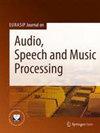钢琴乐谱重新排列成多个难度级别,通过符号到符号的方法
IF 1.9
3区 计算机科学
Q2 ACOUSTICS
Eurasip Journal on Audio Speech and Music Processing
Pub Date : 2023-12-05
DOI:10.1186/s13636-023-00321-7
引用次数: 0
摘要
乐谱重排是符号音乐处理中的一个新兴领域,其目的是将乐谱转换成不同的风格。本研究以钢琴乐谱演奏难度的改变为研究对象,探讨了乐谱重排中存在的两大挑战。首先,我们解决在乐谱上处理乐谱的挑战。虽然符号音乐研究通常依赖于音符级别(midi等效)的信息,乐谱包含不能在音符级别充分表示的符号。我们提出了一个端到端框架,它利用符号的标记化表示来直接在符号级别重新排列乐谱。我们还提出了ST+表示,它包括一种新的结构和标记类型,以便更好地重新排列分数。其次,我们解决了跨多个难度级别重新安排乐谱的挑战。我们引入了一种难度调节方案来训练能够处理不同难度级别的单序列模型,同时利用模型训练中不同级别的分数。我们收集了四个难度级别的商业质量流行钢琴乐谱,并训练了一个MEGA模型(具有0.3M参数)在这些级别之间重新排列。客观评价表明,我们的方法成功地将钢琴乐谱重新排列到其他三个难度级别,达到了与人造乐谱相当的难度。此外,我们的方法成功地生成了包含发音的乐谱。主观评估(由分数专家和音乐家)也表明,我们生成的分数通常在几个标准上超过了以前基于规则或音符级方法的质量。我们的框架支持对乐谱进行新颖的符号到符号的处理,并可应用于各种乐谱重排任务。本文章由计算机程序翻译,如有差异,请以英文原文为准。
Piano score rearrangement into multiple difficulty levels via notation-to-notation approach
Musical score rearrangement is an emerging area in symbolic music processing, which aims to transform a musical score into a different style. This study focuses on the task of changing the playing difficulty of piano scores, addressing two challenges in musical score rearrangement. First, we address the challenge of handling musical notation on scores. While symbolic music research often relies on note-level (MIDI-equivalent) information, musical scores contain notation that cannot be adequately represented at the note level. We propose an end-to-end framework that utilizes tokenized representations of notation to directly rearrange musical scores at the notation level. We also propose the ST+ representation, which includes a novel structure and token types for better score rearrangement. Second, we address the challenge of rearranging musical scores across multiple difficulty levels. We introduce a difficulty conditioning scheme to train a single sequence model capable of handling various difficulty levels, while leveraging scores from various levels in model training. We collect commercial-quality pop piano scores at four difficulty levels and train a MEGA model (with 0.3M parameters) to rearrange between these levels. Objective evaluation shows that our method successfully rearranges piano scores into other three difficulty levels, achieving comparable difficulty to human-made scores. Additionally, our method successfully generates musical notation including articulations. Subjective evaluation (by score experts and musicians) also reveals that our generated scores generally surpass the quality of previous rule-based or note-level methods on several criteria. Our framework enables novel notation-to-notation processing of scores and can be applied to various score rearrangement tasks.
求助全文
通过发布文献求助,成功后即可免费获取论文全文。
去求助
来源期刊

Eurasip Journal on Audio Speech and Music Processing
ACOUSTICS-ENGINEERING, ELECTRICAL & ELECTRONIC
CiteScore
4.10
自引率
4.20%
发文量
0
审稿时长
12 months
期刊介绍:
The aim of “EURASIP Journal on Audio, Speech, and Music Processing” is to bring together researchers, scientists and engineers working on the theory and applications of the processing of various audio signals, with a specific focus on speech and music. EURASIP Journal on Audio, Speech, and Music Processing will be an interdisciplinary journal for the dissemination of all basic and applied aspects of speech communication and audio processes.
 求助内容:
求助内容: 应助结果提醒方式:
应助结果提醒方式:


